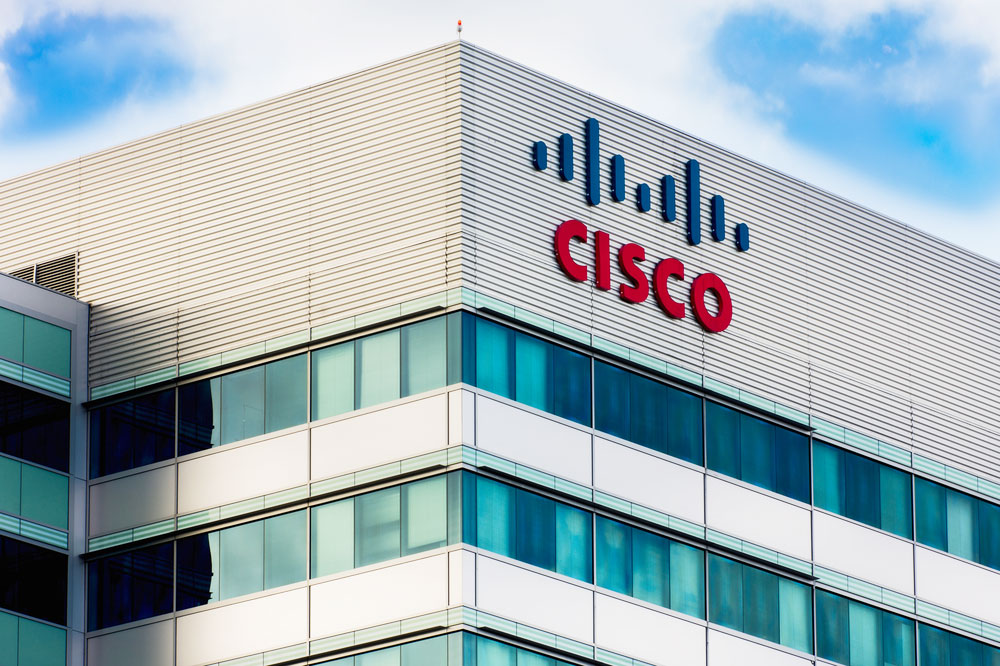Cisco CCIE Security Certification Prep Training Courses
- Description
- Schedule
- What You'll Learn
- Outline
- Prerequisites
- Income Expectations
- Next Step
- Tuition Fee
- Exam
Cisco CCIE Security Certification Prep Training Classes
Implementing Cisco Enterprise Advanced Routing and Services v1.0 (ENARSI 300-410) is a 90-minute exam associated with the CCNP Enterprise Certification. This exam certifies a candidate's knowledge for implementation and troubleshooting of advanced routing technologies and services including Layer 3, VPN services, infrastructure security, infrastructure services, and infrastructure automation. The course, Implementing Cisco Enterprise Advanced Routing and Services, helps candidates to prepare for this exam.
The following topics are general guidelines for the content likely to be included on the exam. However, other related topics may also appear on any specific delivery of the exam. To better reflect the contents of the exam and for clarity purposes, the guidelines below may change at any time without notice.
Cisco CCIE Security Certification Objective
Layer 3 Technologies
VPN Technologies
Infrastructure Security
Infrastructure Services
Implementing Cisco Enterprise Advanced Routing and Services
Layer 3 Technologies
Troubleshoot administrative distance (all routing protocols)
Troubleshoot route map for any routing protocol (attributes, tagging, filtering)
Troubleshoot loop prevention mechanisms (filtering, tagging, split horizon, route poisoning)
Troubleshoot redistribution between any routing protocols or routing sources
Troubleshoot manual and auto-summarization with any routing protocol
Configure and verify policy-based routing
Configure and verify VRF-Lite
Describe Bidirectional Forwarding Detection
Troubleshoot EIGRP (classic and named mode)
- Address families (IPv4, IPv6)
- Neighbor relationship and authentication
- Loop-free path selections (RD, FD, FC, successor, feasible successor, stuck in active)
- Stubs
- Load balancing (equal and unequal cost)
- Metrics
Troubleshoot OSPF (v2/v3)
- Address families (IPv4, IPv6)
- Neighbor relationship and authentication
- Network types, area types, and router types
- Point-to-point, multipoint, broadcast, nonbroadcast
- Area type: backbone, normal, transit, stub, NSSA, totally stub
- Internal router, backbone router, ABR, ASBR
- Virtual link
- Path preference
Troubleshoot BGP (Internal and External)
- Address families (IPv4, IPv6)
- Neighbor relationship and authentication (next-hop, mulithop, 4-byte AS, private AS, route refresh, synchronization, operation, peer group, states and timers)
- Path preference (attributes and best-path)
- Route reflector (excluding multiple route reflectors, confederations, dynamic peer)
- Policies (inbound/outbound filtering, path manipulation)
VPN Technologies
Describe MPLS operations (LSR, LDP, label switching, LSP)
Describe MPLS Layer 3 VPN
Configure and verify DMVPN (single hub)
- GRE/mGRE
- NHRP
- IPsec
- Dynamic neighbor
- Spoke-to-spoke
Infrastructure Security
Troubleshoot device security using IOS AAA (TACACS+, RADIUS, local database)
Troubleshoot router security features
- IPv4 access control lists (standard, extended, time-based)
- IPv6 traffic filter
- Unicast reverse path forwarding (uRPF)
Troubleshoot control plane policing (CoPP) (Telnet, SSH, HTTP(S), SNMP, EIGRP, OSPF, BGP)
Describe IPv6 First Hop security features (RA guard, DHCP guard, binding table, ND inspection/snooping, source guard)
Infrastructure Services
Troubleshoot device management
- Console and VTY
- Telnet, HTTP, HTTPS, SSH, SCP
- (T)FTP
Troubleshoot SNMP (v2c, v3)
Troubleshoot network problems using logging (local, syslog, debugs, conditional debugs, timestamps)
Troubleshoot IPv4 and IPv6 DHCP (DHCP client, IOS DHCP server, DHCP relay, DHCP options)
Troubleshoot network performance issues using IP SLA (jitter, tracking objects, delay, connectivity)
Troubleshoot NetFlow (v5, v9, flexible NetFlow)
Troubleshoot network problems using Cisco DNA Center assurance (connectivity, monitoring, device health, network health)
Implementing Cisco SD-WAN Solutions Certification Prep Training Courses Classes
Architecture
Describe Cisco SD-WAN Architecture and Components
- Orchestration plane (vBond, NAT)
- Management plane (vManage)
- Control plane (vSmart, OMP)
- Data plane (vEdge)
- TLOC
- IPsec
- vRoute
- BFD
- Describe WAN Edge platform types, capabilities (vEdges, cEdges)
Controller Deployment
Describe controller cloud deployment
Describe Controller on-Prem Deployment
- Hosting platform (KVM/Hypervisor)
- Installing controllers
- Scalability and redundancy
Configure and verify certificates and whitelisting
Troubleshoot control-plane connectivity between controllers
Router Deployment
Describe WAN Edge deployment
- On-boarding
- Orchestration with zero-touch provisioning/plug-and-play
- Single/multi data center/regional hub deployments
Configure and verify SD-WAN data plane
- Circuit termination/TLOC-extension
- Underlay-overlay connectivity
Configure and verify OMP
Configure and verify TLOCs
Configure and verify CLI and vManage feature configuration templates
- VRRP
- OSPF
- BGP
Policies
Configure and verify control policies
Configure and verify data policies
Configure and verify end-to-end segmentation
- VPN segmentation
- Topologies
Configure and verify SD-WAN application-aware routing
Configure and verify direct Internet access
Security and Quality of Service
Configure and verify service insertion
Describe application-aware firewall
Configure and verify QoS treatment on WAN edge routers
- Scheduling
- Queuing
- Shaping
- Policing
Management and Operations
- Describe monitoring and reporting from vManage
- Configure and verify monitoring and reporting
- Describe REST API monitoring
- Describe software upgrade from vManage
Designing Cisco Enterprise Networks Certification Prep Training Courses Classes
Advanced Addressing and Routing Solutions
Create structured addressing plans for IPv4 and IPv6
Create stable, secure, and scalable routing designs for IS-IS
Create stable, secure, and scalable routing designs for EIGRP
Create stable, secure, and scalable routing designs for OSPF
Create stable, secure, and scalable routing designs for BGP
- Address families
- Basic route filtering
- Attributes for path preference
- Route reflectors
- Load sharing
Determine IPv6 migration strategies
- Overlay (tunneling)
- Native (dual-stacking)
- Boundaries (IPv4/IPv6 translations)
Advanced Enterprise Campus Networks
Design campus networks for high availability
- First Hop Redundancy Protocols
- Platform abstraction techniques
- Graceful restart
- BFD
Design campus Layer 2 infrastructures
- STP scalability
- Fast convergence
- Loop-free technologies
- PoE and WoL
Design multicampus Layer 3 infrastructures
- Convergence
- Load sharing
- Route summarization
- Route filtering
- VRFs
- Optimal topologies
- Redistribution
Describe SD-Access Architecture (underlay, overlay, control and data plane, automation, wireless, and security)
Describe SD-Access fabric design considerations for wired and wireless access (overlay, fabric design, control plan design, border design, segmentation, virtual networks, scalability, over the top and fabric for wireless, multicast)
WAN for Enterprise Networks
Compare WAN connectivity options
- Layer 2 VPN
- MPLS Layer 3 VPN
- Metro Ethernet
- DWDM
- 4G/5G
- SD-WAN customer edge
Design site-to-site VPN
- Dynamic Multipoint VPN (DMVPN)
- Layer 2 VPN
- MPLS Layer 3 VPN
- IPsec
- Generic Routing Encapsulation (GRE)
- Group Encrypted Transport VPN (GET VPN)
Design high availability for enterprise WAN
- Single-homed
- Multihomed
- Backup connectivity
- Failover
Describe Cisco SD-WAN Architecture (orchestration plane, management plane, control plane, data plane, on-boarding and provisioning, security)
Describe Cisco SD-WAN design considerations (control plane design, overlay design, LAN design, high availability, redundancy, scalability, security design, QoS and multicast over SD-WAN fabric)
Network Services
Select appropriate QoS strategies to meet customer requirements (DiffServ, IntServ)
Design end-to-end QoS policies
- Classification and marking
- Shaping
- Policing
- Queuing
Design network management techniques
- In-band vs. out-of-band
- Segmented management networks
- Prioritizing network management traffic
Describe multicast routing concepts (source trees, shared trees, RPF, rendezvous points)
Design multicast services (SSM, PIM bidirectional, MSDP)
Automation
Choose the correct YANG data model set based on requirements
Differentiate between IETF, Openconfig, and Cisco native YANG models
Differentiate between NETCONF and RESTCONF
Describe the impact of model-driven telemetry on the network
- Periodic publication
- On-change publication
Compare dial-in and dial-out approaches to model-driven telemetry
Cisco CCIE Security Certification Prep Training Program
- This course is designed for individuals who have basic computer user skills and who are interested in obtaining a job as an entry-level IT technician.
- HS Diploma/GED
Cisco CCIE Security Certification
Income Expectation
$113,322/yr
The average salary for a Cisco CCIE Security Certified Employee is $113,322 in New York City. Salary estimates are provided by CISCO.
Upon completion of this course, and the certifying exam(s), the student will be qualified to take a job as a
Cisco CCIE Security
Cisco CCIE Security Certification Prep Training Classes Courses
CCIE Collaboration
CCIE Data Center
CCIE Service Provider
Cisco CCIE Security Certification Prep Training Courses Classes
$12,000
Implementing Cisco Enterprise Advanced Routing and Services Certification Prep Training Courses Classes
Implementing Cisco Enterprise Advanced Routing and Services v1.0 (ENARSI 300-410) is a 90-minute exam associated with the CCNP Enterprise Certification.
CCIE Security v5.0
CCIE Security v6.0

